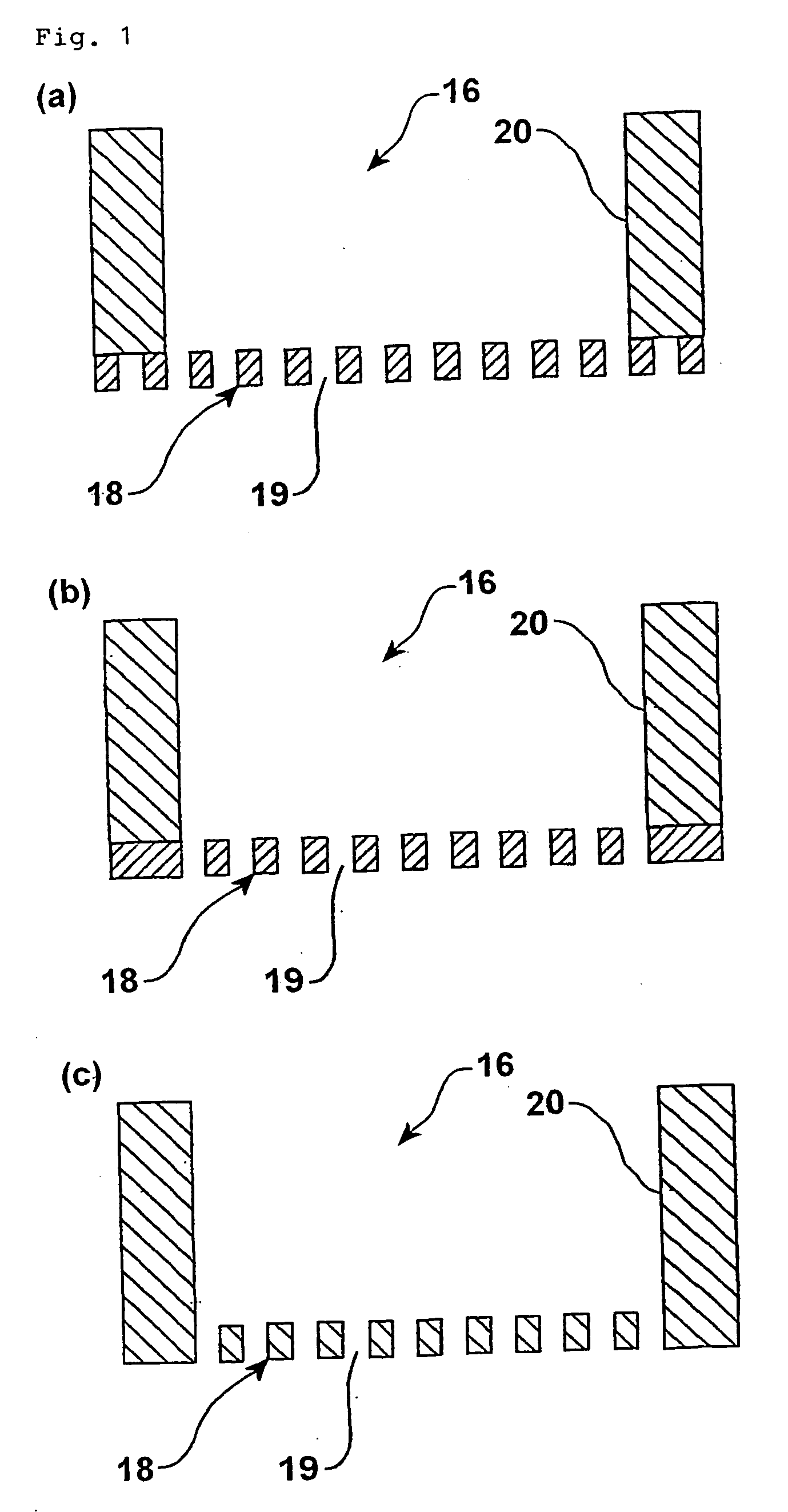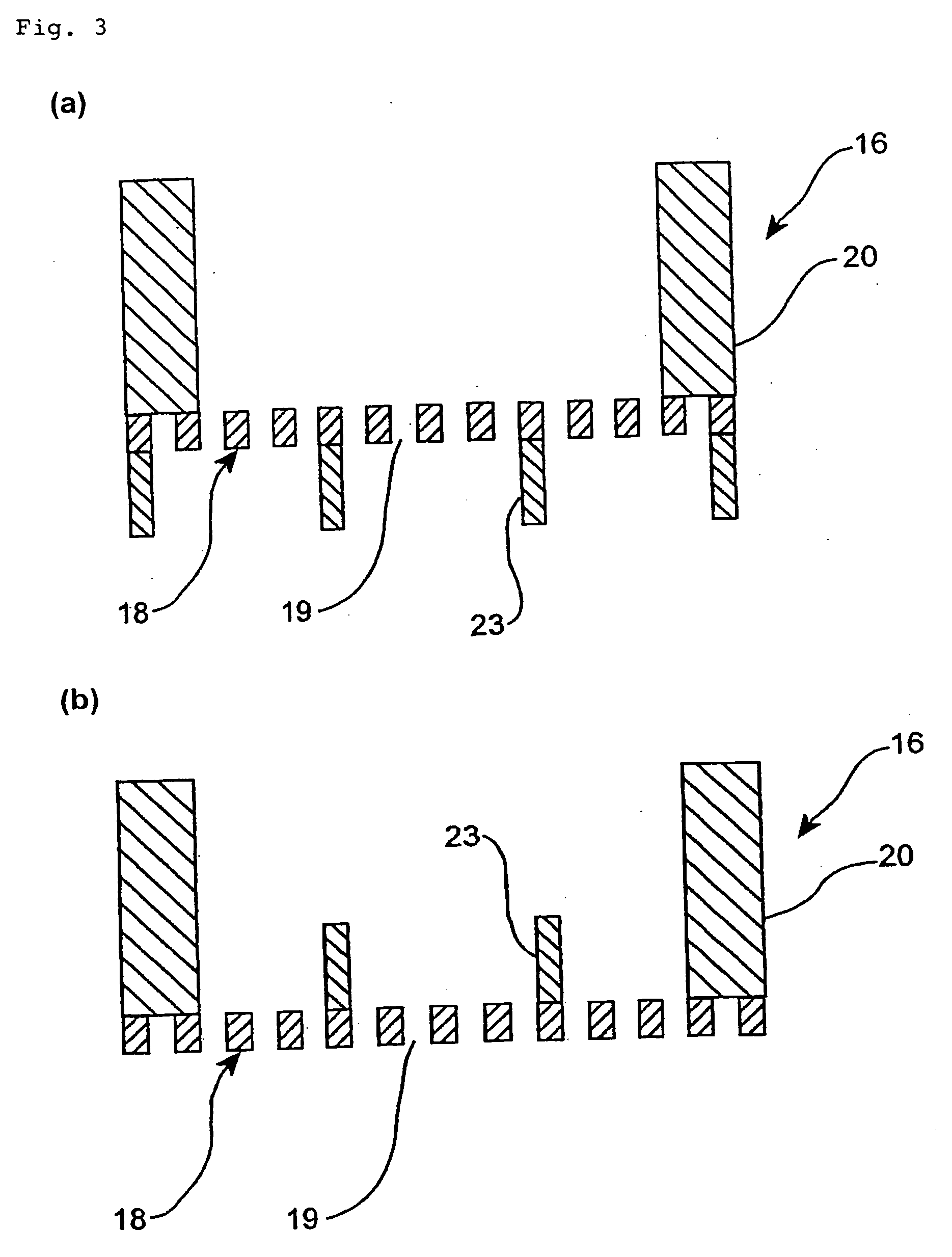Biochip and biochip kit, and method of producing the same and method of using the same
a biochip and kit technology, applied in the field of biochips, can solve the problems of inability to treat small number of analytes, inability to produce whole chips, and inability to meet the requirements of biochips,
- Summary
- Abstract
- Description
- Claims
- Application Information
AI Technical Summary
Benefits of technology
Problems solved by technology
Method used
Image
Examples
example 1
Preparation of Filter and Rib by Electroforming
1. Preparation of Filter
[0402] A resist THB-110N (tradename: manufactured by JSR Corporation) was spin coated onto a stainless steel substrate (SUS 304, dimension 120 mm×120 mm×1 mm in thickness) to a thickness of 5 μm, and the coating was prebaked on a hot plate at 120° C. for 5 min. After the prebaking, the coating was exposed in a predetermined pattern form using a mask aligner M-3LDF (tradename: manufactured by Mikasa Corp.) at an exposure of 400 mJ / cm2 so that non-electroplated parts remain unremoved. Development was carried out with a developing solution PD523 (tradename: manufactured by JSR Corporation), followed by post-baking on a hot plate at 90° C. for 5 min.
[0403] Next, the SUS substrate which had been patterned using the resist THB-110N was placed in a nickel sulfamate bath (composition of bath: 700 g / liter 60% nickel sulfamate solution, 5 g / liter nickel bromide, 35 g / liter boric acid, 1.5 g / liter stress regulator, and...
example 2
Preparation of Filter and Rib by Etching of Silicon Wafer with Oxide Film
1. Preparation of Filter
[0406] A resist IX1170G (tradename: manufactured by JSR Corporation) was spin coated using a spinner (CLEAN TRACK MARK 8 (tradename): manufactured by Tokyo Electron Limited) on a 6-in. silicon wafer (thickness: 2 μm) with an oxide film at 3300 rpm for 30 sec. The coating was dried on a hot plate (CLEAN TRACK MARK 8 (tradename: manufactured by Tokyo Electron Limited)) at 90° C. for 60 sec to form a 0.86 μm-thick resist film. This resist film was exposed using a reduced projection exposure system NSR-2205i12D (tradename: manufactured by NIKON CORPORATION, NA=0.57, sigma=0.60) at an exposure of 0.4 umC / H 1000 msec and 0.8 umC / H 580 msec, and paddle development was then carried out with a developing solution PD523AD (tradename: manufactured by JSR Corporation) at 23° C. for one min. Next, water washing was carried out for 20 sec, followed by drying to form a resist pattern.
[0407] CF4 pl...
example 3
[0410] A solution prepared by diluting bovine serum with PBS (phosphate buffered saline) by 10 times was provided. The chip prepared in Example 2 having a filter pore diameter of 4.0 μm and a pore spacing of 2.0 μm was provided. The chip was set in the vessel shown in FIG. 16 (b). A tube was set in the upper lid, and a tank containing the diluted solution of bovine serum was connected to the other end face of the tube. The height of the tank was set so that a differential pressure of 4 gf / cm2 and 18 gf / cm2 could be provided. The diluted solution of bovine serum was flowed to the filter part in the chip vessel, and the diluted solution of bovine serum was discharged from the lower lid in the lower vessel. The relationship between the total discharge amount and the discharge time is shown in FIG. 30.
[0411] As shown in the drawing, the amount of discharge from the filter was substantially constant, and, during the evaluation period, neither clogging nor breaking occurred.
PUM
| Property | Measurement | Unit |
|---|---|---|
| thickness | aaaaa | aaaaa |
| size | aaaaa | aaaaa |
| pressure | aaaaa | aaaaa |
Abstract
Description
Claims
Application Information
 Login to View More
Login to View More - R&D
- Intellectual Property
- Life Sciences
- Materials
- Tech Scout
- Unparalleled Data Quality
- Higher Quality Content
- 60% Fewer Hallucinations
Browse by: Latest US Patents, China's latest patents, Technical Efficacy Thesaurus, Application Domain, Technology Topic, Popular Technical Reports.
© 2025 PatSnap. All rights reserved.Legal|Privacy policy|Modern Slavery Act Transparency Statement|Sitemap|About US| Contact US: help@patsnap.com



